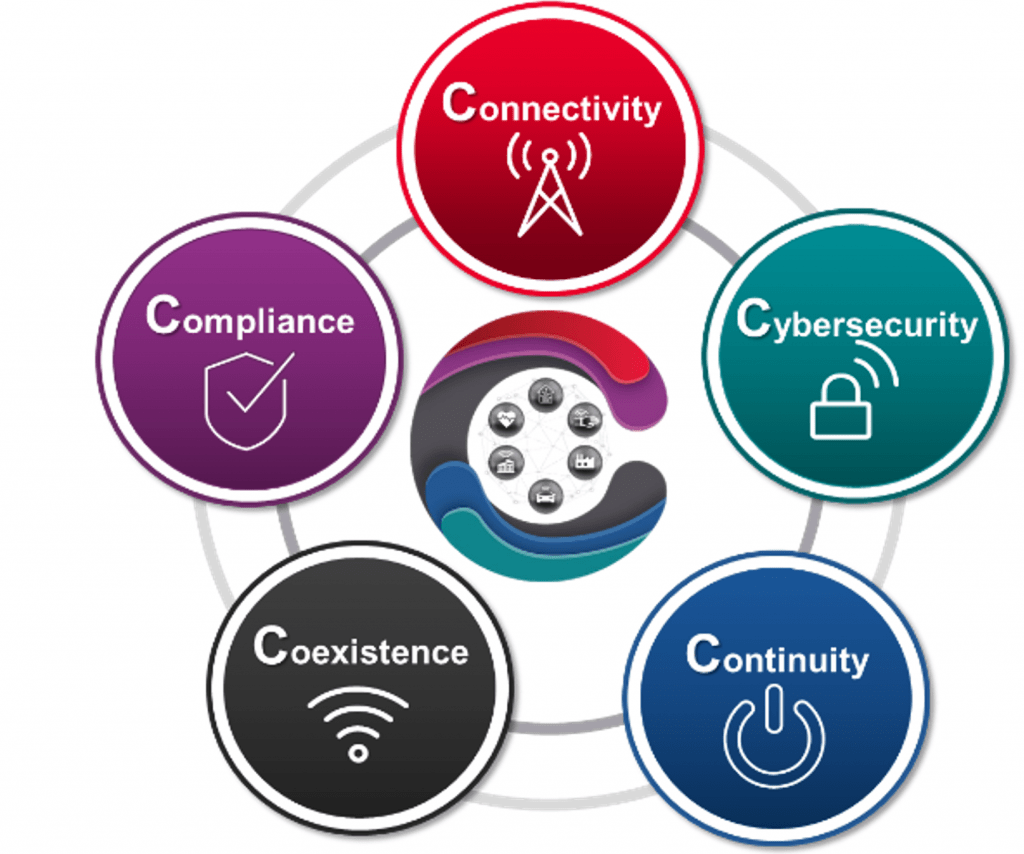When incorporating IoT into operational technologies for public safety, emergency response and medical care, there is zero tolerance for failure.
Internet of Things (IoT) deployment is diversifying from consumer-based applications such as smart home devices and wearables to mission-critical applications. The technology can be found in the areas of public safety, emergency response, industrial automation, autonomous vehicles and the Internet of Medical Things (IoMT).
As these mission-critical applications proliferate, engineers and designers must address important design and test considerations and trade-offs, from the early design phase to the final manufacturing outcomes.
The 5Cs of addressing IoT challenges
IoT opens doors to exciting new applications and opportunities for many industries. But it also brings unprecedented challenges that require thinking in new ways to meet mission-critical requirements.
Delivering successful IoT means overcoming IoT’s 5Cs of technical challenges, including Connectivity, Continuity, Compliance, Coexistence and Cybersecurity.

- Connectivity: Enabling a seamless flow of information to and from a device, infrastructure, cloud and applications, is a top IoT challenge because wireless connectivity is highly complex, and dense device deployments further complicate operations.
Yet, mission-critical IoT devices are expected to work without fail even in the toughest environments. Fast-evolving wireless standards add to the complexity, and engineers face constant challenges in keeping pace with the latest technologies while ensuring devices can work seamlessly throughout the ecosystem.
Responding to connectivity challenges requires design and test solutions that are highly flexible, configurable and upgradable to meet future needs. Flexibility is needed to test devices with many radio formats, to assess device performance under actual operation modes, and to support over-the-air (OTA) testing in signaling mode without the need for a chipset-specific driver.
The solution should be simple, inexpensive, and usable in both R&D and manufacturing to leverage code and minimize measurement correlation issues across the different phases of development. - Continuity: Ensuring and extending battery life is one of the most important considerations for IoT devices. A long battery life is a huge competitive advantage in consumer IoT devices. For industrial IoT devices, a battery life of five or 10 years is the common expectation. For medical devices such as pacemakers, this can mean the difference between life and death. Furthermore, battery failure is not an option.
To meet IoT battery life requirements, integrated circuit (IC) designers need to design ICs with deep sleep modes that consume very little current and reduce clock speed and instruction sets, as well as implementation on low battery voltages.
For wireless communications, standards groups are defining new low power consumption operating modes such as NB-IoT, LTE-M, LoRa, Sigfox that offer limited active operation time while maintaining low power consumption.
Designers who integrate sensing, processing, control and communication components into a final product must know how the peripherals behave and consume power, and optimize the product firmware and software to simplify operation and reduce consumption. - Compliance: IoT devices must adhere to radio standards and global regulatory requirements. Compliance testing includes radio standards conformance and carrier acceptance tests, and regulatory compliance tests such as RF, EMC, and SAR tests. Design engineers often scramble to meet tight product introduction timelines and ensure smooth global market entry while complying to the latest regulations, which are frequently updated.
Because compliance testing is complex and time-consuming, it can take days or weeks to complete if performed manually. To keep to a product release schedule, designers can consider investing in in-house pre-compliance test solutions they can use at every design stage, to fix issues early. Choosing one that is adapted from the test lab compliance system can also help to ensure measurement correlation and reduce risk of failures. - Coexistence: With billions of wireless devices in use, congestion in the radio channels is a problem that will only get worse. To address wireless congestion, standards bodies have developed test methodologies to evaluate device operations in the presence of other signals.
For instance, in Bluetooth, adaptive frequency hopping (AFH) lets a device drop channels that experience high data collisions. Other collision avoidance techniques such as listen before talk (LBT) and cooperative collision avoidance (CCA) also improve transmission effectiveness.
But effectiveness in a mixed-signal environment is unknown, and when the radio formats do not detect each other, collisions and data losses will occur.
An industrial sensor that loses the control signal, or a medical infusion pump that stops working due to surrounding interference, can create dire consequences. Coexistence testing is therefore crucial, to measure and assess how a device will operate in a crowded, mixed signal environment, and to assess the potential risk in maintaining wireless performance in the presence of unintended signals found in the same operating environment. - Cybersecurity: Most traditional cybersecurity protection tools have focused on network and cloud. Endpoint and over-the-air (OTA) vulnerabilities are frequently overlooked. While mature technologies like Bluetooth and WLAN are used in many applications, little has been done to address the OTA vulnerabilities.
The complexity of these wireless protocols translates into potential unknown pitfalls in device radio implementations that could allow hackers to access or take control of a device.
According to IDC, 70% of security breaches originate from endpoints. Extra care should be taken to safeguard these IoT devices. OTA vulnerabilities and potential point of entries into endpoint devices should be identified, and devices should be tested using a regularly-updated database of known threats/attacks to monitor device response and detect anomalies.
Having a deep understanding of these challenges and knowing what the key design and test considerations are, will build a strong foundation for implementation and deployment across the ecosystem.
The use of right design, validation, compliance testing, manufacturing and security tools throughout the product lifecycle will help to ensure that IoT delivers on its promises.
